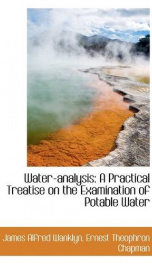arsenic

Purchase of this book includes free trial access to www.million-books.com where you can read more than a million books for free. This is an OCR edition with typos. Excerpt from book: hydrogen gas may be passed into the liquid, when the following may be noted. In the cold, at ordinary temperatures, the action of the gas is exceedingly slow, twenty-four hours being required to complete the production of the yellow sulphuret As2S3; but, if the liquid be warmed up to 60 or 70 Centigrade, then the production of the yellow sulphuret is almost immediate. The equation expressing the chemical reaction is: 5H2S+As205 = 5H20+As2S3+S2, and, as will be perceived, there is production of sulphur in addition to the yellow sulphuret As2S3. Instead of directly passing the sulphuretted hydrogen through a heated solution of arsenic acid it will be found convenient to employ sulphurous acid, and, in that way, reduce the arsenic acid into arsenious acid before resorting to sulphuretted hydrogen. The chemical change may be expressed thus : As205 + 2S02 = As203+ 2S03. Of course the 2S03 acts upon water and becomes 2(S03H20). The solution should be warmed in order to facilitate the chemical change. Section 3. The Chloride and the Hydride of Arsenic. Chloride of arsenic, formula AsCl3, theoretical vapour-density = 6.289. Dumas found 6.300. It is a heavy colourless liquid, which decomposes water when brought into contact with water. Its boilingpoint is 132 Centigrade. It is produced by distilling a mixture of common salt and arsenious acid with excess of sulphuric acid, and is a highly poisonous liquid which fumes in moist air owing to the action of its vapour on moisture. There is no pentachloride of arsenic. Bromine and iodine form corresponding compounds. The iodide AsI3 is a beautiful substance described as an orange-coloured sublimate. It is prepared by heating a mixture of iodine and metallic arsenic. It is very soluble in hot water, and, curiously en...
Info about the book
Author:
Series:
Unknown
ASIN:
B001KDT0ZW
Rating:
4.5/5 (3)Your rating:
0/5
Languge:
English
Users who have this book
Users who want this book
What readers are saying
What do you think? Write your own comment on this book!
write a commentGenre
if you like arsenic try:
Other books by this author
Do you want to read a book that interests you? It’s EASY!
Create an account and send a request for reading to other users on the Webpage of the book!



